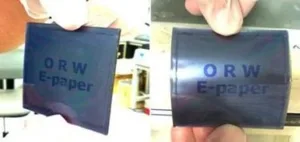A team of researchers from Donghua University (Shanghai, China) and Hong Kong University of Science and Technology has just reported on advances that the team has made on Optically Re-Writable Liquid Crystal Display (ORWLCD) technology. The figure below illustrates a prototype of the flexible ORWLCD.
A prototype of the flexible ORWLCD.
Details on the materials and fabrication of the ORWLCD prototype can be found in a recent publication by the team that was entitled “A flexible optically re-writable color liquid crystal display.” The article was published in Appl. Phys. Lett. 112, 131902 (2018). A copy of the article is available for purchase on-line and can be found here.
In addition, the newsletters of Meko and Display Daily have previously reported on this team’s development of ORWLCD technology. One such article can be found here.
The Background
Drawing from these and other sources, here are a few words of background information on flexible ORWLCD technology.
The ORWLCD uses a re-writable bistable optical effect to switch individual pixels from a light state to a dark state. The re-writing is done using polarized light applied by a separate device. Since the optical effect is bistable, energy is consumed only when the image is changed. The result is a large reduction in the energy consumed by an ORWLCD as compared to a conventional LCD of a similar size.
The optical approach used in the ORWLCD also allows for the use of a wide range of materials for the display substrates. As a result, the weight and thickness of an ORWLCD can be significantly less than an equivalent conventional LCD. In fact, an ORWLCD can weigh only a few grams and be less than half a millimeter thick. The structure of the ORWLCD suggests that it will be durable and inexpensive to manufacture.
One of the reasons that an ORWLCD lends itself to a design that is flexible is that the drive device and the display are physically separate. More specifically, that there are no electronics in the display part of the ORWLCD.
The Challenges
The first challenge in achieving a flexible ORWLCD was the choice of substrate material. The team reported the selection of polyethersulfone.
The next challenge related to the gap that contains the liquid crystal between the two substrates. The size and uniformity of the gap is determined and controlled by the use of spacers. A consistant gap spacing is necessary for the display to produce a uniform image.
The reason there is a challenge related to gap control in a flexible LCD is that, when the substrates flex, the gap can change and cause the liquid crystal material to flow. This, in turn, can cause sections of the image produced by the display to have highly visible variations in contrast ratio, response time or viewing angle.
Recent Work
In their most recent work, the researchers report on the investigation of three different spacer designs. It was determined that a mesh-like spacer was most effective in preventing the liquid crystal from flowing when the ORWLCD was flexed.
The Display Daily article referred to above pointed out that, about three years ago when that article was written, the prototype ORWLCD could produce only grayscale images. The team stated their belief that, with further development, color could be added. Regarding this point, progress has indeed been achieved. In their most recent publication, the team reports that the latest prototype ORWLCD can now simultaneously present the three primary colors. This was accomplished by placing red, green and blue cholesteric liquid crystal reflectors and a polarizer behind the pixels of the LCD.
In order to transition the prototype ORWLCD into a commercial product, one team member explained that “Now we have three colors, but for full color we need to make the pixels too small for human eyes to see.” In other words, the next task for the team is to increase the pixel resolution of the ORWLCD. – Arthur Berman
Donghua University, Jiatong Sun, [email protected]

